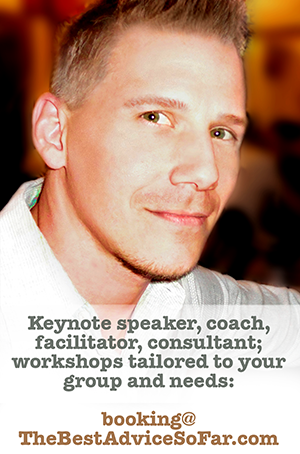
I fully realize that, upon initial consideration, you may think that something is very wrong with me; but I realized something tonight in a new way. I realized that I enjoy seeing skin stretched and creased. What’s more (and please don’t judge), I actually get even a little more pleasure from seeing skin folds pulled back and separated to reveal the bone underneath.
The really weird thing is … you probably do, as well.
I mean, think about it. Isn’t that all a smile really is: flaps of skin being pulled away to show underlying bone? C’mon, work with me. Don’t you find it kind of bizarre, when described physiologically, that such a process could signify – and invoke – joy? It’s a curiosity, for certain; but it’s the most wonderful of mysteries, if you ask me.
Last night, I ventured out for dinner alone, following the siren song of sushi. As is the case with many such authentic Thai restaurants, the tables were placed mere inches apart. After I was seated and had ordered my meal, I noticed out of the corner of my eye that the little girl seated to my left, no more than seven, was staring at me wide-eyed and smiling a too-big smile (with the obligatory missing teeth). I turned to look at her and couldn’t help smiling back myself. “Hello!” she chimed. “Hello!” I echoed back cheerily.
Her father placed his hand correctively on her shoulder: “Honey, don’t bother that man. He’s trying to eat.”
I found this odd, since my food hadn’t even arrived yet, and no more than a glass of ice water adorned the table. It made me a little sad, to tell you the truth. It wasn’t so long ago that children were actually instructed as part of standard etiquette to greet others with a pleasant smile and cordial “hello.” What happened, to have left these former markers of civility and proper upbringing the cause for mild chastisement, or being seen as a “bother”?
I cautiously assured the man that I was not bothered in the least, but that his daughter had brightened my evening. I expressed how amazed I was that our culture doesn’t do more of what his daughter seemed to understand so readily. We’ve become experts at ignoring the people we rub elbows with on the daily commute, in the airplane row beside us, or just waiting in the checkout line. But why?
When I give voice lessons, I instruct students about how to use their mouths to achieve better pitch and tone. When going for Pop or Gospel sounds, or in reaching for those higher notes, I always tell them “Smile! Show those upper teeth!” This is real technique.
Actually, if you’re up for experimenting with me (whether you consider yourself a singer or not), you can even prove this to yourself right now. Form a round mouth, like the letter “O,” trying not to show any teeth – then sing a note and hold it. Listen to what you hear. Now, open your mouth in a smile that reveals your upper teeth clearly. Sing and hold the same note (or one close to it, if you aren’t sure). Do you hear the difference? Try morphing your mouth from the “O” to the smile mid-note: you should definitely hear the change! (Don’t worry: today’s voice lesson is on the house.)
What I’m saying is that there is real acoustic science to it. Smiling subtly changes not only the shape of the space inside our mouth, but the tension on the back and sides of the tongue, as well as of the soft palate (i.e., the back of the roof of your mouth). So when we smile, not only do we elevate our own mood and the mood of others around us, we actually alter the sound of our voice, from sounding thick and somber to sounding clear and warm. And this is perceived by others as part of the mood we convey. A neutral or down-turned mouth makes us sound sullen, melancholy and disinterested; while a smile actually causes our voice to be perceived as light, confident and inviting.
While we’re reducing smiles to skin and bones, and discussing the science behind them, here are a couple more fascinating facts.
Studies have long shown that the very act of smiling, whether we initially “feel happy” or not, produces positive personal gains at clinically significant levels.
In one study, participants were asked to hold a pen in their mouths. Group One held the pen tip between their lips (causing a physiological “pout”); Group Two held the pen lengthwise between their teeth (causing a physiological “smile”); and a third control group held no pen in their mouths. Each participant was then asked to view some of Gary Larsen’s Far Side cartoons and rate how funny they thought they were. Can you guess which group rated the cartoons as funnier? (If you picked Group Two, you are brilliant – and correct.)
In another study, participants in three groups were asked to hold a pair of chopsticks in their mouths, paralleling the pen experiment outlined above. They then had one hand completely submerged in ice water for a minute. Physical distress was measured, as well as information gathered as to recovery time before people felt “back to normal” afterward. Again, can you guess which group fared the best in terms of stress management?
In short, science has proven that smiling works wonders.
That little girl and I at the Thai restaurant didn’t happen to be holding our chopsticks between our teeth (though check back with me after a future visit, and that might change). But we were still putting good science, good etiquette – and just plain old good vibrations – into play.
I hope you found today’s post informative and entertaining. But my bigger hope is that it’s given you a few more convincing reasons … to SMILE.
Are you ready for some real change in your life right now?
The Best Advice So Far is about choice. Filled with wit, humor and poignantly real stories, The Best Advice So Far shares collective wisdom through a new lens, as well as practical application for living like it matters (because it does).












August 24th, 2015 at 12:46 AM
Erik, Your story reminds me of my experience in Kenya a few years ago. I saw many children who were impoverished relative to American standards. But nearly every child had a toothy grin, and seemed happy. By Western standards they had nothing to smile about. But with the science you share here it’s obvious that we don’t need a reason to smile–we just need to smile more.
LikeLiked by 1 person
August 24th, 2015 at 7:13 AM
Absolutely, John. And do let me say that, while I styled this post around science, I do also believe there is a soul component – a mystery – to smiling, as well. Kenya is definitely on my list. What had you there?
LikeLike
June 27th, 2015 at 12:01 AM
[…] Each time you meet somebody’s eyes and smile. […]
LikeLike
June 19th, 2015 at 9:29 PM
Great little piece, Erik. It’s so true: For whatever reason — social mistrust spurred by myriad news stories of unspeakable cruelty, smartphone technology that relentlessly diverts our attention from the dinner companion sitting across from us — in this age of mass communication, we’re unconsciously, and quite ironically, rewiring our behavior to the point where it’s second nature to establish a relationship, such as it is, with a digital avatar — as much as it is, alas, to habitually disengage from those we pass on the street. We need, as a culture, to restore trust in one another — and to appreciate direct human contact once again. We have the tools to do it: science. Grand gestures notwithstanding, it doesn’t cost anything, as you illustrate, to share a smile and send some good vibes into the ether. Thanks for the reminder…
LikeLiked by 1 person
June 19th, 2015 at 11:14 PM
Yes, I think that fear plays a big part in what is happening. Everyone looks like a possible threat. But I don’t know that the world has any more “creepers” in it than it did when people smiled and said “hello” more. I think it’s just that with more and more media channels available and pumping information 24/7, we are just made aware of the exceptions more than in “the good old days.” I’m not letting anything stop me, personally. The times that engaging has positive results far outweigh any negative fallout.
Thanks for reading and sharing your unique take, Sean.
LikeLiked by 1 person
June 19th, 2015 at 6:33 PM
The whole beginning of your post- where you contemplate what to me, seemed to be things of a physiological grotesque nature – almost instantaneously morphed into a post about bringing more joy into this sad world of ours. What a turnabout. Thanks for your nice article.
LikeLiked by 1 person
June 19th, 2015 at 6:39 PM
Hello! Yes, I do like to keep people on their distal phalanges (i.e., toes). Actually, I just like the curiosity factor and element of surprise in writing. Thanks for reading and for sharing your thoughts!
LikeLiked by 1 person
June 19th, 2015 at 3:43 PM
I love this post! You are so right, we assume people don’t want to be bothered. The truth is that lots of people feel invisible & unnoticed amongst a sea of people. And this can actually increase the feeling of emptiness inside. A simple smile can go a long way.
I recently shared with a friend that my favorite part of the day is returning home from work, seeing the enormous smiles on the faces of my three girls, as they shout, “daddy’s home!” In fact, just thinking about this makes me happy! The act of smiling is simple. Yet, the value it adds to others can be enormous! Thank you for an excellent reminder of the value of “stretching skin over bone”–love it!
LikeLiked by 2 people
June 19th, 2015 at 3:52 PM
And your comment with its insight and images has spread the smile to over here, Jed. 😀
LikeLiked by 1 person